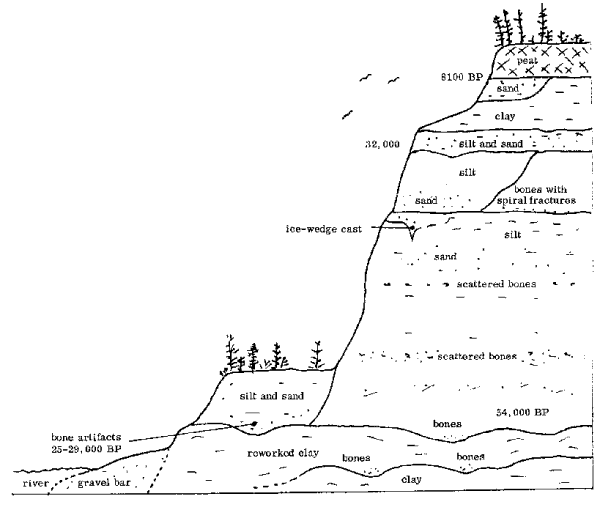 |
Science Frontiers ONLINE No. 51: May-Jun 1987 |
|
|
When were the americas peopled?
For more than 50 years, archeological dogma has had the first Americans trooping across the Bering Land Bridge about 12,000 years ago -- about 2,000 years before the termination of the Ice Ages. Despite tight discipline among most professional archeologists (jobs and grants go only to approved individuals), a few cracks are beginning to appear. As reported in SF#47, a Brazilian site has now been reliably dated at 32,000 years. If these early Brazilians came over the Bering Land Bridge, they must have left even earlier traces in North America. In fact, there are two hotly debated North American sites that seem to be very much older than the one in Brazil; namely, the Calico site in California; and a spot along the Old Crow River in the Yukon.
Thousands of stone artifacts, apparently showing signs of being shaped by humans, have been recovered at Calico over the past two decades. The Calico artifacts are usually contemptuously dismissed as naturally fractured chert flakes. But at the other end of the belief spectrum (Don't laugh, much of science is just as much of a belief system as religion!) are those who see a long human history at Calico. B. Bower writes:
"Two periods of human occupation have been dated at Calico. From about 15,000 to 20,000 years ago the area was inhabited by what [R.D.] Simpson suggests was a huntinggathering people with more sophisticated tools, including stones flaked on both sides. In deeper layers estimated to be at least 200,000 years old are the simpler flakes of people, she says, who probably gathered plants and other foods."
Much farther north, along the Yukon's Old Crow River, nearly 10,000 horse-and mammoth-bone artifacts have been picked up and dug out of the river banks. W.N. Irving, from the University of Toronto, claims that the last five seasons of archeological research have uncovered a 'bone industry' of extremely great age -- 100,000 years or more. (Bower, Bruce; "Flakes, Breaks, and the First Americans," Science News, 131:172, 1987.)
Comment. It seems significant that French archeologists explored the Brazilian site and Canadians, the Old Crow site. American archeologists, with a few exceptions here and there, scoff at the whole business.
Reference. The handbook Ancient Man goes into early American archeology in great depth. For ordering information, visit: here.
| Composite section of the Old Crow site. Notice the complexity of the stratigraphy. (Adapted from R. E. Morlan's paper in Early Man in America, A. L. Bryan, ed., p. 81). | 
|